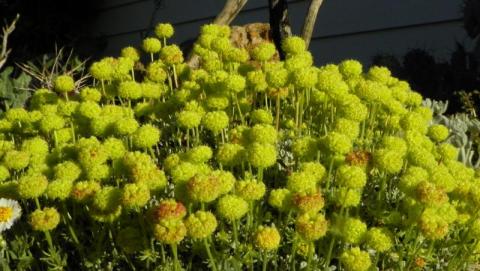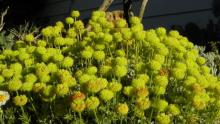Eriogonum douglasii var. meridionale is a great mat for the garden. It forms a silvery gray cushion two inches tall and up to twelve inches across. The leaves are densly lanate on both surfaces. In early spring it is studded with one inch yellow pompoms suspended atop two-three inches slender scapes. In bud they display a blush of ocher red. When the flower heads are through blooming they change color to a deep rust and can hang around all summer before they shatter.
E. douglasii var. meridionale is native to CA, NV, and OR. I have found it growing on slopes composed of a matrix of heavy clay and broken volcanic rock. In the early spring these slopes can turn into a quagmire. By late summer they are brick hard.
I have known people to mistake this plant for E. caespitosum there is an easy way to differentiate them. E. douglasii var. meridionale will have a whorl of bracts midway up the scapes.

Comments
Mark McDonough
Re: Eriogonum douglasii var. meridionale
Wed, 11/24/2010 - 7:29amA classic beauty this buckwheat is, love the 2nd photo which shows such gorgeous foliage and clear lemon flowers.
Seeing this one sends me off onto another research frenzy, because one of my very favorite Eriogonums found on my many field trips to the Wenatchee Mountains, Kittitas Co, Washington, back in the mid 1980s, was one that keyed to E. douglasii var. tenue. What made the variety different is that the leaf edges are revolute, curled under so strongly thet the densely hirsute leaves looked needle-like. It grew interspersed with Penstemon gairdneri, this Penstemon always in two color forms, a violet blue and an electric pure blue, growing into small bonsai shrubs also with needle-like narrow leaves. The Eriogonum was primarily in shades of yellow, cream, and pink, but almost every imaginable shade of red, pink, to deep raspberry could also be found. I never succeeded in ghrowing either this eriogonum and penstemon.
Looking into the nomenclature on this one is a literal maze, including some current day contradictions.
First I go to the USDA Plant Profile pages: they list two varieties; var. douglasii and var. sublineare.
The variety sublineare includes the previous "var. tenue", cited as a synonum.
http://plants.usda.gov/java/profile?symbol=ERDOS
So, I check out the ITIS status (Integrated Taxonomic Information System), and they list Eriogonum douglasii var. sublineare (S. Stokes) Reveal as "accepted".
http://www.itis.gov/servlet/SingleRpt/SingleRpt?search_topic=TSN&search_...
I move on to the Burke Museum of Natural History website (a superb resource), and they too accept E. douglasii var. sublineare and show some nice photos:
http://biology.burke.washington.edu/herbarium/imagecollection.php?Genus=...
...a red-budded one:
http://biology.burke.washington.edu/herbarium/imagecollection/imagelarge...
...close-up of revolute leaves:
http://biology.burke.washington.edu/herbarium/imagecollection/imagelarge...
Last, I look up E. douglasii in Flora of North America, 3 varieties are listed; var. douglasii, var. meridionale, var. elkoense, but where is var. sublineare (or var. tenue)? Nowhere to be found, and not listed in synonymy for any of those 3 varieties; FONA drives me crazy because they often drop synonyms or fail to cross-reference them. A google search reveals that this entity is in FONA as:
Eriogonum sphaerocephalum Douglas ex Bentham var. sublineare (S. Stokes) Reveal
http://www.efloras.org/florataxon.aspx?flora_id=1&taxon_id=250060507
In the FONA treatment, they give the following synonyms:
E. douglasii var. tenue
E. caespitosum Nuttall var. sublineare S. Stokes
E. douglasii var. tenue (Small) C. L. Hitchcock
...but they fail to cite the additional synonyms:
E. tenue Small.
E. sphaerocephalum subsp. tenue (Small) Piper
E. douglasii Benth. var. sublineare (S. Stokes) Reveal
E. strictum Benth. var. tenue (Small) S. Stokes
Some of my older references are the most values, even though the taxonomy is outdated, because they reveal so much more detail and are filled with beautiful line drawings, suchas in the 4-volume encyclopedic Illustrated Flora of the Pacific Northwest by Leroy Abrams, 1944. Here's a scan of a page of Eriogonum drawings showing E. douglasii and what was listed as E. tenue at that point in time; the Klickitat Eriogonum.
Trond Hoy
Re: Eriogonum douglasii var. meridionale
Wed, 11/24/2010 - 8:53amJohn, one more i have to try! This will never end....
Richard T. Rodich
Re: Eriogonum douglasii var. meridionale
Wed, 11/24/2010 - 9:53amAll this Eriogonum talk is really beginning to turn my previously ho-hum thoughts about the genus.
Mark, that 4 volume Flora is a real treasure!
John P. Weiser
Re: Eriogonum douglasii var. meridionale
Wed, 11/24/2010 - 11:24amMark
give me a little time and we will take a look at Eriogonum sphaerocephalum var. sphaerocephalum in my limited experience one of the best subshrubs in the genus.
Hoy
Not for a little while. I still have nine more to go and I am hoping someone else will post a few more.
As a side note I grow nineteen species, varieties and forms in my garden as adult plants and have five new species and one variety started as seedlings.
Rick
I am glad you are enjoying the show!
Mark McDonough
Re: Eriogonum douglasii var. meridionale
Wed, 11/24/2010 - 8:17pmI used to peruse the lists of natural history book purveyors/resellers, and there are some amazing finds. I bought my 4-volume Illustrated Flora of the Pacific Northwest for a mere $30, the 4 volumes stacked up measure 8" deep. Almost every taxa is illustrated with a fine line drawing; as they say, they just don't make em like that anymore. They often give more insight and history behind taxonomy than current day publications.
take a look at the NARGS Photo Gallery pages too, there are 3 pages of really good photos, some exquisite eriogonums.
http://nargs.org/nargswiki/tiki-browse_gallery.php?galleryId=61
Trond Hoy
Re: Eriogonum douglasii var. meridionale
Thu, 11/25/2010 - 3:55amI am looking forward to new pictures!
However, I was addressing myself but didn't express it right. I meant to say one more species to try to get hold of!
John P. Weiser
Re: Eriogonum douglasii var. meridionale
Thu, 11/25/2010 - 5:52amHoy
I know were your coming from. ;) I have a wish list longer than my arm and all winter to dream about them. Thank goodness the seed lists are coming out they are always a good read! "Fuel for the fire," as they say! ;D
Trond Hoy
Re: Eriogonum douglasii var. meridionale
Fri, 11/26/2010 - 12:13amExactly! The problem is where to grow all those plants?
John P. Weiser
Spring 2014 display. It is
Thu, 05/01/2014 - 10:48amSpring 2014 display. It is about a month ahead of last season. We have been above normal for spring temperatures this year.

Trond Hoy
Weiser wrote:
Mon, 05/05/2014 - 12:59pm[quote=Weiser]
Spring 2014 display. It is about a month ahead of last season. We have been above normal for spring temperatures this year.
[/quote]
Sorry, can't see any pictures?
John P. Weiser
Sorry when I preview my
Mon, 05/05/2014 - 1:12pmSorry when I preview my posting the photo shows on my computer. I'll try again.
Trond Hoy
Thanks John. Now I can see
Fri, 05/09/2014 - 11:04pmThanks John. Now I can see them in both posts!
Very nice.